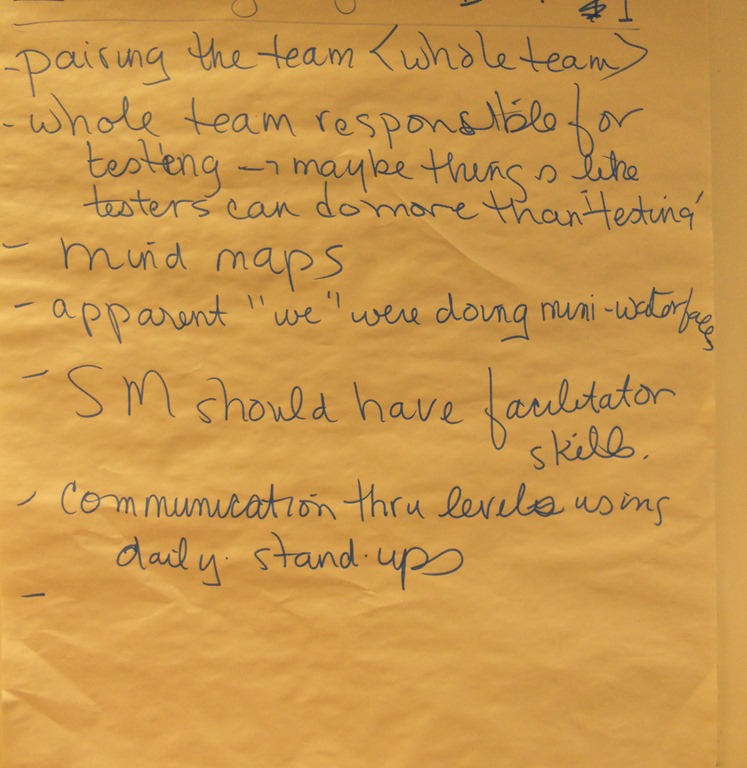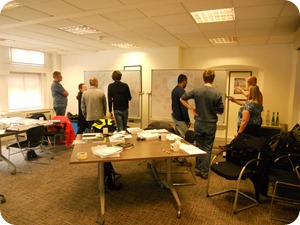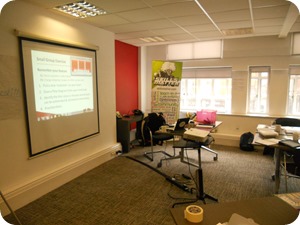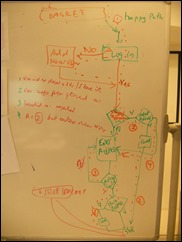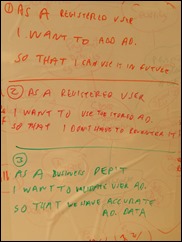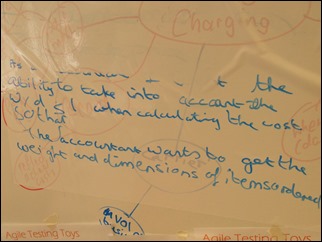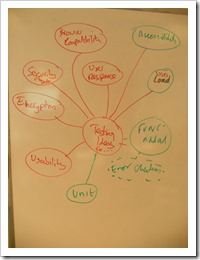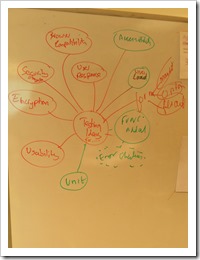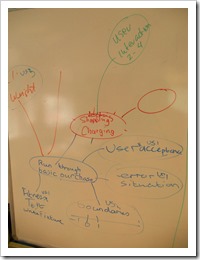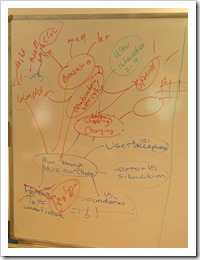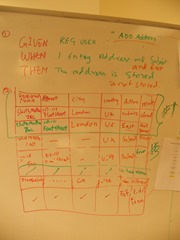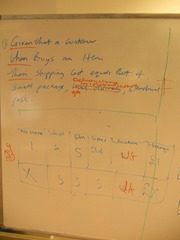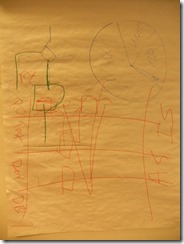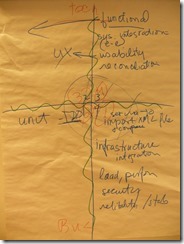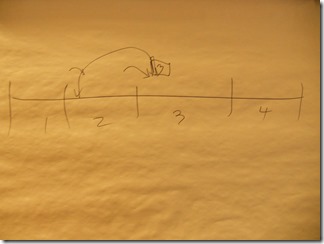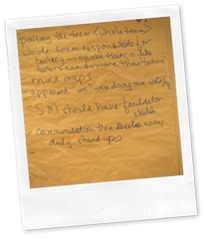 Here comes my memory of today’s training course, detailed thoughts of mine will be updated later.
Here comes my memory of today’s training course, detailed thoughts of mine will be updated later.
In the beginning of today, Janet first did an exercise “Your Learning from Day 1”, to collect the learning that participants got from yesterday’s course, and they’re all on the flipchart pictured below, not many, but good learning still. My pictures of today were all about the exercises, and I blogged according to pictures, so I’ll give you an overview of the modules we had today here altogether: 1, finish the left part of “Making Automation Work”; 2, the “Release Planning”; 3, the “Test Planning in Agile Projects”; 4, part of “An Iteration in the Life of a Tester”.
If you ever wondered how does the training room looks like and how we work on the training exercises, here you are. I took those 2 pictures while we’re doing the exercise of drawing “Flow Diagrams”for our Mind-Maps. Everybody was facing to the whiteboard and focusing on the discussion, so it should be safe to post the pictures without asking for their permissions… The room is big enough for an 8 people training, while the logistics is fairly good too, well, maybe the air conditioning was not… and since it’s beside the street, many times the street noise or traffic sounds were annoying. However, the room is high enough and bright and in concise style which I like, moveable tables, 2 big whiteboards, 1 flipchart shelf, that’s good for an interactive training.
So, as indicated above, we did an exercise of “Flow Diagram” to extend the basis flow of given “Selecting Toys and Shopping Cart Flow”, to reflect the feature which each team selected yesterday. While finished the flow, we need to find out the paths which Janet & Lisa would call “Steel Threads”, first the most core thread, then the next one and another, and so on. And we have to find at least three threads. After find out the threads, we can convert them into User Stories, in the format of “As a …, I Want…, So That…”. Below are the work results of our two teams, for the features of “Store Customer Information”and “Change shipping charges to reflect actual costs”.
The major differences between two teams’ ways of working was uncovered in the next exercise – use mind-map to collect testing ideas for our feature / user-stories. As shown in the pictures, we did it in different ways. Our group (1st picture below) started from the feature in the middle, and then went to sub-topics by different types of testing, e.g. functional, unit, usability, security, etc. While another group (3rd picture below) was more based on / for each single user story. Well, I was thinking in the same way as the other group did, but it was killed by or say didn’t get enough support within our team. This is a very good approach, coz every team member had their chance to share their opinions about what should this mind-map looks like quickly, then synergy and proceed with the one opinion that everybody agrees.
I walked out of the room during a break, when I came back, it seems Janet had helped each team to modify their mind-maps, I couldn’t catch up it on live, but I can at least took pictures ![]() Check below, the 2nd picture is the update of the 1st one; and the 4th one is the update of the 3rd one.
Check below, the 2nd picture is the update of the 1st one; and the 4th one is the update of the 3rd one.
After that, we did the exercise to write down the tests for our user stories, using both the format of GWT (Given-When-Then) and Tabular Format. I think it’s a very good exercise (from giving training point of view) and also a very good practice (from daily use point of view), coz those 2 formats focus on or say lead you to different aspects which are both important.
- GWT forces you to think about the “Conditions/Pre-Conditions”of your tests, and the action that you do to experience the functionality you want to test – the“Trigger”, and what are those“Outputs”to verify the results and your “Expected Value of those Outputs”.
- Tabular Format, is kind of easy to lead you think in the way of Data-Driven tests, within the table of same fields / parameters, the tests will be pretty much similar ones with different values of fields. And it forces you to think if a certain field is really important or relative to this specific test set.
Below are the results of our 2 teams. Left one is our teams’, right one is from the other team.
Finally, I took photos of all Janet’s hand drawings today too. 1st one is about when Janet explains the Swim Lane of ATDD procedures; 2nd is about the “Agile Testing Quadrants”, and the circles in the centre is, to emphasize that the numbering of quadrants doesn’t mean the priorities of them nor the sequence of doing them; 3rd one is about the timing when to do “Pre-Planning”.
* Blog posts for Day 3 will be added after each day later.
Below are links on some topics mentioned during training:

